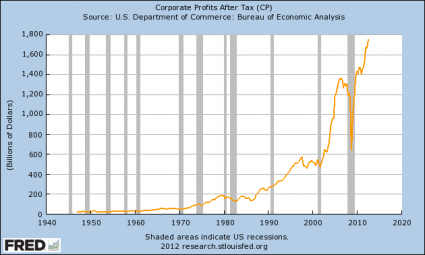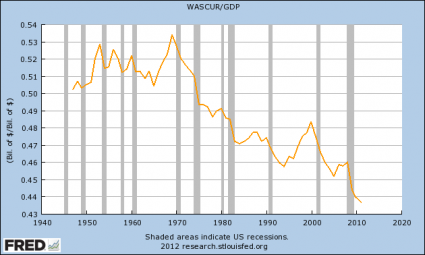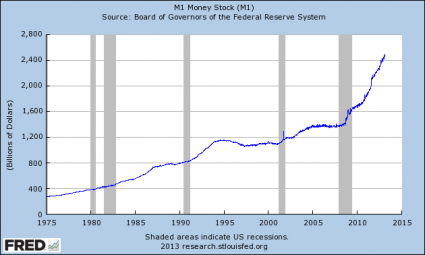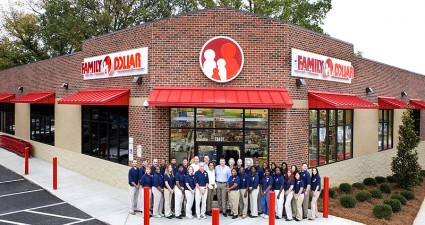 The Dow is at a record high and so are corporate profits – so why does it feel like most of the country is deeply suffering right now? Real household income is the lowest that it has been in a decade, poverty is absolutely soaring, 47 million Americans are on food stamps and the middle class is being systematically destroyed. How can big corporations be doing so well while most American families are having such a hard time? Isn’t their wealth supposed to “trickle down” to the rest of us? Unfortunately, that is not how the real world works. Today, most big corporations are trying to minimize the number of “expensive” American workers on their payrolls as much as they can. If the big corporation that is employing you can figure out a way to replace you with a worker in China or with a robot, it will probably do it. Corporations are in existence to maximize wealth for their shareholders, and most of the time the largest corporations are dominated by the monopoly men of the global elite. Over the decades, the politicians that have their campaigns funded by these monopoly men have rigged the game so that the big corporations are able to easily dominate everything. But this was never what those that founded this country intended. America was supposed to be a place where the power of collectivist institutions would be greatly limited, and individuals and small businesses would be free to compete in a capitalist system that would reward anyone that had a good idea and that was willing to work hard. But today, our economy is completely and totally dominated by a massively bloated federal government and by absolutely gigantic predator corporations that are greatly favored by our massively bloated federal government. Our founders tried to warn us about the dangers of allowing government, banks and corporations to accumulate too much power, but we didn’t listen. Now they dominate everything, and the rest of us are fighting for table scraps.
The Dow is at a record high and so are corporate profits – so why does it feel like most of the country is deeply suffering right now? Real household income is the lowest that it has been in a decade, poverty is absolutely soaring, 47 million Americans are on food stamps and the middle class is being systematically destroyed. How can big corporations be doing so well while most American families are having such a hard time? Isn’t their wealth supposed to “trickle down” to the rest of us? Unfortunately, that is not how the real world works. Today, most big corporations are trying to minimize the number of “expensive” American workers on their payrolls as much as they can. If the big corporation that is employing you can figure out a way to replace you with a worker in China or with a robot, it will probably do it. Corporations are in existence to maximize wealth for their shareholders, and most of the time the largest corporations are dominated by the monopoly men of the global elite. Over the decades, the politicians that have their campaigns funded by these monopoly men have rigged the game so that the big corporations are able to easily dominate everything. But this was never what those that founded this country intended. America was supposed to be a place where the power of collectivist institutions would be greatly limited, and individuals and small businesses would be free to compete in a capitalist system that would reward anyone that had a good idea and that was willing to work hard. But today, our economy is completely and totally dominated by a massively bloated federal government and by absolutely gigantic predator corporations that are greatly favored by our massively bloated federal government. Our founders tried to warn us about the dangers of allowing government, banks and corporations to accumulate too much power, but we didn’t listen. Now they dominate everything, and the rest of us are fighting for table scraps.
In early America, most states had strict laws governing the size and scope of corporations. Individuals and small businesses thrived in such an environment, and the United States experienced a period of explosive economic growth. We showed the rest of the world that capitalism really works, and we eventually built the largest middle class that the world had ever seen.
But now we have replaced capitalism with something that I like to call “corporatism”. In many ways, it shares a lot of characteristics with communism, and that is why nations such as communist China have embraced it so readily. Under “corporatism”, monolithic predator corporations run around sucking up as much wealth and economic power as they possibly can. Most individuals and small businesses cannot compete and end up getting absorbed by the corporations. These mammoth collectivist institutions are in private hands rather than in government hands (as would be the case under a pure form of communism), but the results are pretty much the same either way. A tiny elite at the top gets almost all of the economic rewards.
There are some out there that would suggest that the answer to our problems is to move more in the direction of “socialism”, but to be honest that wouldn’t be the solution to anything. It would just change how the table scraps that the rest of us are getting are distributed.
If we truly wanted a return to prosperity, we need to dramatically shift the rules of the game so that they are tilted back in favor of individuals and small businesses. A much more pure form of capitalism would mean more wealth, less poverty and a more equitable distribution of the economic rewards in this country.
But it will never happen. Most of our politicians are married to the big corporations and the wealthy elitists that fund their campaigns. And most Americans are so uneducated that they believe that what we actually have today is “capitalism” and that the only alternative is to go “to the left” toward socialism.
Very few people out there are suggesting that we need to greatly reduce the power of the federal government and greatly reduce the power of the big corporations, but that is exactly what we need to do. We need to give individuals and small businesses room to breathe once again.
With each passing year, things get even worse. In fact, the founder of Subway Restaurants recently said that the environment for small businesses is so toxic in America today that he never would have been able to start Subway if he had to do it today.
For much more on how small business is being strangled to death in the United States, please see my previous article entitled “We Are Witnessing The Death Of Small Business In America“.
What I want to do now is to discuss some of the results that “corporatism” is producing in America.
First of all, we continue to see incomes go down even though we live in an inflationary economy.
As Time Magazine recently reported, personal incomes took a huge nosedive during the month of January…
Data released by the Commerce Department last week showed that personal income fell 3.6% in January, the biggest decline in 20 years. The drop was even bigger when taxes and inflation are taken into account. Real personal disposable income fell by 4%, the biggest monthly drop in half a century.
But this is part of a longer term trend. Median household income in the U.S. has declined for four consecutive years, and it is now significantly lower than it was all the way back in 2001…
Real median US household income — that’s “real,” as in “adjusted for inflation” — was $50,054 in 2011, the most recent data available from the US Census Bureau. That’s 8% lower than the 2007 peak of $54,489.
Meanwhile, big corporations are absolutely raking in the cash. The following is from a recent New York Times article…
“So far in this recovery, corporations have captured an unusually high share of the income gains,” said Ethan Harris, co-head of global economics at Bank of America Merrill Lynch. “The U.S. corporate sector is in a lot better health than the overall economy. And until we get a full recovery in the labor market, this will persist.”
The result has been a golden age for corporate profits, especially among multinational giants that are also benefiting from faster growth in emerging economies like China and India.
Today, corporate profits as a percentage of U.S. GDP are at an all-time high, but wages as a percentage of U.S. GDP are near an all-time low.
Just check out the following chart. Corporate profits have absolutely exploded over the past decade…
Meanwhile, wages as a percentage of GDP continue to fall rapidly…
Most of the jobs being created in America today are “low wage” jobs. Tens of millions of Americans are working as hard as they can only to find that they can barely put food on the table and provide a roof over the heads of their children. The ranks of the “working poor” are exploding and the middle class continues to shrink.
Many of you that are reading this article are members of the working poor. You know what it is like to stare up at your ceiling at night wondering how you are going to pay the bills next month.
Today, most Americans are living very close to the edge financially. A recent article by NBC News staff writer Allison Linn shared some of their stories. The following is one example…
Crystal Dupont knows what it’s like to try to live on the federal minimum wage.
Dupont has no health insurance, so she hasn’t seen a doctor in two years. She’s behind on her car payments and has taken out pawn shop and payday loans to cover other monthly expenses. She eats beans and oatmeal when her food budget gets low.
When she got her tax refund recently, she used the money to get ahead on her light bill.
“I try to live within my means, but sometimes you just can’t,” said Dupont, 25. The Houston resident works 30 to 40 hours a week taking customer service calls, earning between $7.25 and $8 an hour. That came to about $15,000 last year.
It’s a wage she’s lived on for a while now, but just barely.
Sadly, the number of Americans that are “just barely” surviving continues to grow.
But if corporate profits are soaring to unprecedented heights, then who is getting all of those rewards?
The monopoly men of the global elite are.
Just check out the following video which does a great job of illustrating how corporatism has systematically funneled all of the economic rewards in our system to the very top…
Once again, I want to make it very clear that I am not advocating socialism as the answer in any way, shape or form. Socialism takes away the incentive to create wealth and it almost always results in almost all of the economic rewards going to a very tiny elite anyway.
As I said earlier, what we need is a return to a much more pure form of capitalism, but this is so foreign to the way that most people think that most people will not be able to grasp this.
It certainly would be possible to greatly reduce the power of the federal government and greatly reduce the power of the big corporations at the same time, but this is so “outside the box” for most people that they cannot even conceive of doing such a thing.
We need to create an environment where individuals and small businesses can thrive once again. But instead, most of us are content to continue “playing the game” and getting enslaved in even more debt.
For example, according to CNBC, auto loans just continue to get larger and continue to get stretched out for longer periods of time…
American car buyers, attracted by new models and cheap financing, are taking out bigger auto loans and stretching out the terms of those loans to a new record length.
New analysis from Experian Automotive shows the average new car loan in the fourth quarter of last year was $26,691 and stretched out over an average of 65 months. The length of the average loan is one month longer than the previous record set in the third quarter of last year.
What will they think of next?
Will we eventually have auto loans that get paid off over 10 years?
By the way, that is another way that the monopoly men of the global elite get all of our money. They enslave us to debt, and we spend year after year of our lives slaving away to make them even wealthier.
They are very smart. There is a reason why they have 32 TRILLION dollars stashed away in offshore tax havens. They know how to play the game, and they are very happy that most of the rest of us are asleep.
Fortunately, it appears that an increasing number of Americans are waking up.
For example, I wanted to share with you all an excerpt from a comment that one of my readers left on one of my recent articles…
In the past year, I’ve been slowly but surely waking up to the nonsense happening around me. There’s so many things I need to simply get off my chest, so excuse the length of this post. Recently in the past two years, I’ve gotten married and have been medically discharged from the Marines after being injured in Afghanistan. Being 23 years old and married, my goal is secure a secure a future for my family, but with the way things are going, I’m not exactly sure how much of a future we’re going to have in 50 years. I can’t explain it, but I’ve felt this need to change my attitude and motivations lately.
I started by turning off the garbage music, television and other mindless entertainment that seems to plague my generation. It was easier than it looked – I don’t miss most of it really. The next order of business was to educate myself on world news, so that’s what I did. Every day, like clockwork, I check all major mainstream news feeds (NBC, Fox, Abc, CNN, Reuters, BBC, etc.) as well as not-so-mainstream news sites – yours being one of them. It’s incredible how fast our world changes and the manner in which it changes. The local 10 o’clock doesn’t show anything but local news, sports, weather, lottery #’s and whatever else they decide to throw in. It’s a night and day difference once you start to actually research and see what’s happening all over the world. Look at the number of comments about a news story on the economy and then look at a celebrity story on the “news”….People are so blind, it truly amazes me. My friends, family and classmates at college seem to be under a spell of some sort. They’re distracted – and it’s contagious. Nobody I know gives a damn about global affairs/economics. They’re more interested in the newest iPhone, cars, shows, movies, and just about anything else you can think of. I’m not saying there’s anything wrong with these things, but my friends/family/peers are CONSUMED by these distractions. When the election was taking place in 2012, every Tom, Dick and Harry on Facebook had an opinion and rant. After the circus ended however, everyone simply went back to posting about parties, kittens, Farmville etc. It’s a huge joke. For me, it’s little terrifying and exciting to see history unfolding in front of our eyes. This country of ours is going through big changes now that will most certainly affect our future, so I strive to adapt and prepare myself and my family. I’m looking at buying my first home this summer. Right now I live in an apartment right outside Philly and spend more money on rent than most pay for a mortgage. I need a house with a little land to raise chickens, grow fruits/vegetables, store canned food – and to be as independent from the system as I can. For my job, I wanted a skill/trade that people would always need, so I picked the funeral business. On the side, I work in construction and have been learning everything there is to know about building with my own two hands. I feel as though these old forgotten skills are going to be handy in a short while.
Hopefully we can get a lot more people to wake up and start breaking out of “the matrix” of control that is all around us.
Right now, the system is designed to continually funnel more money and more power to the very top of the pyramid. The global elite are becoming more dominant with each passing day. Unless something dramatic happens, at some point the American people will become so powerless that they won’t be able to do anything about it even if they wanted to.
The idea of a very tiny elite completely dominating all the rest of us goes against everything that America is supposed to stand for. In the end, it will result in absolute tyranny if it is not stopped.

















